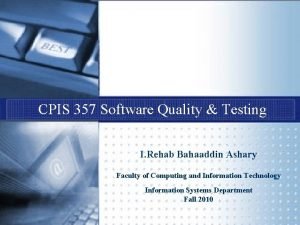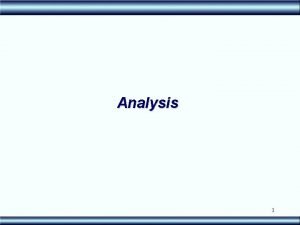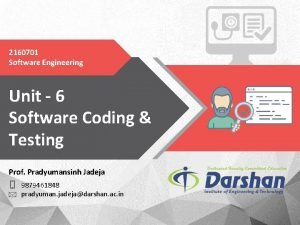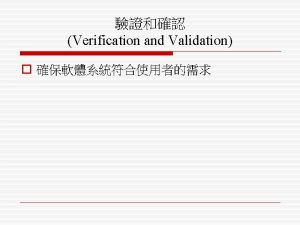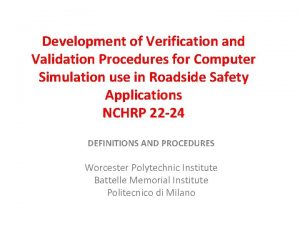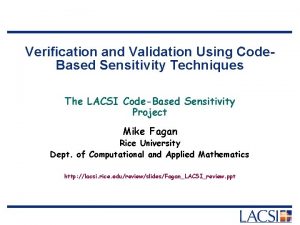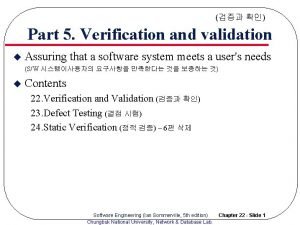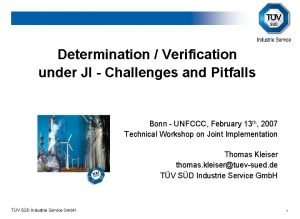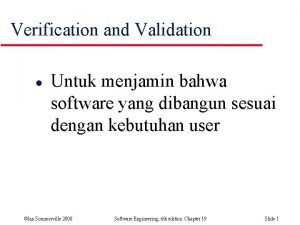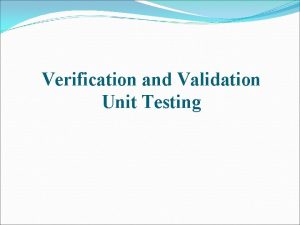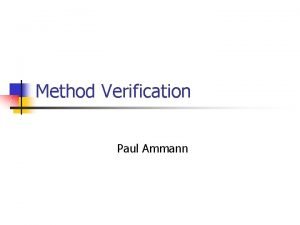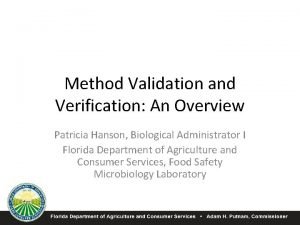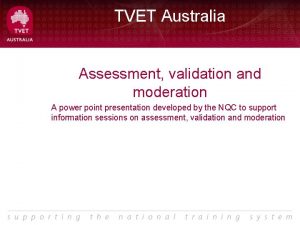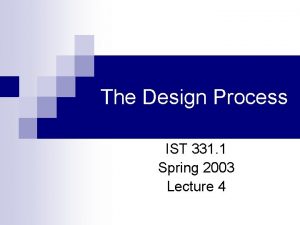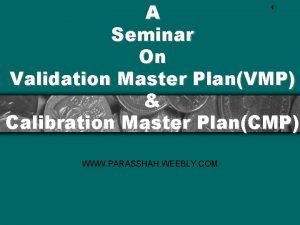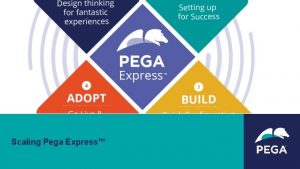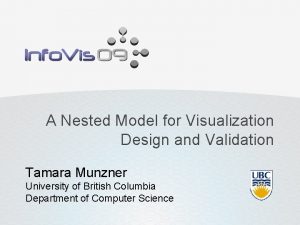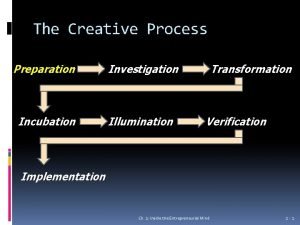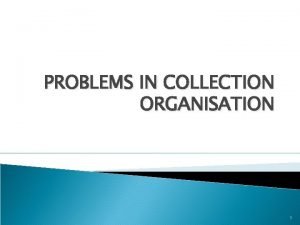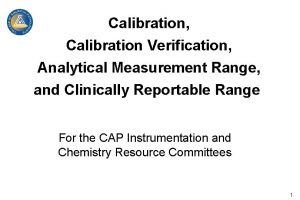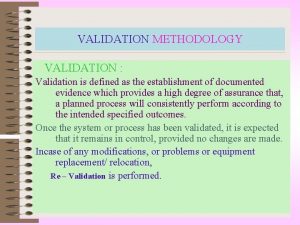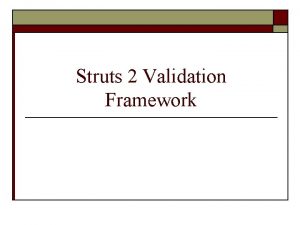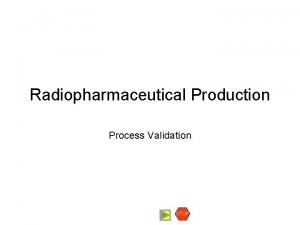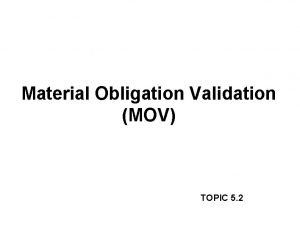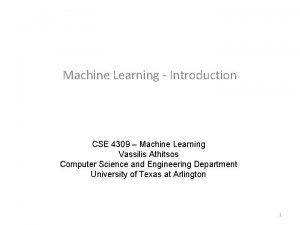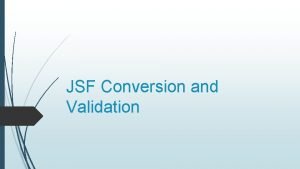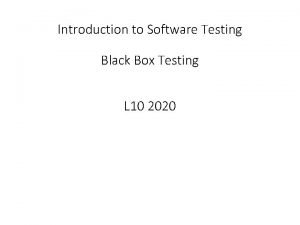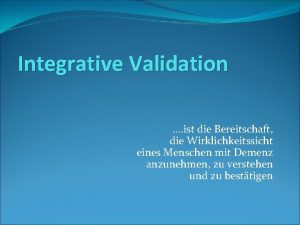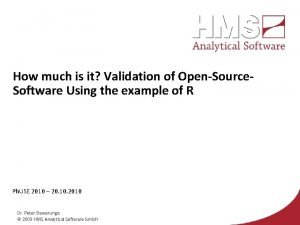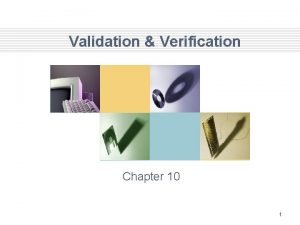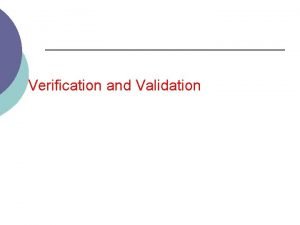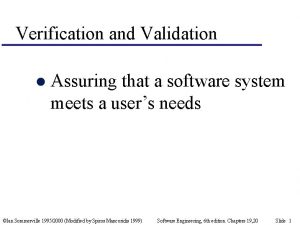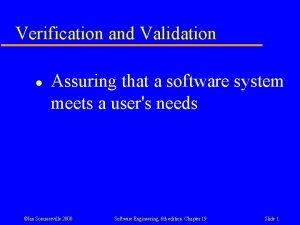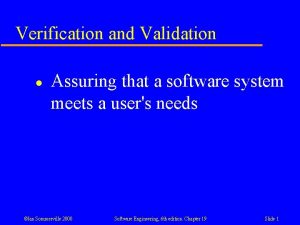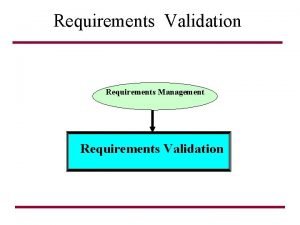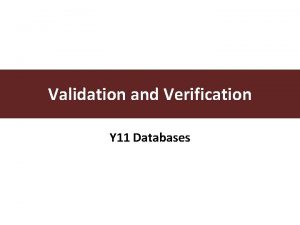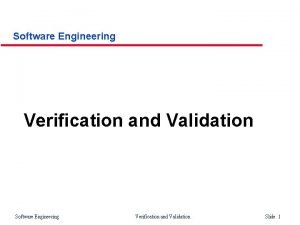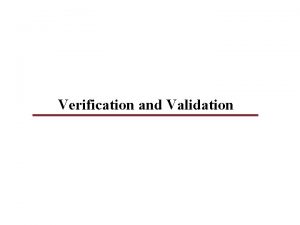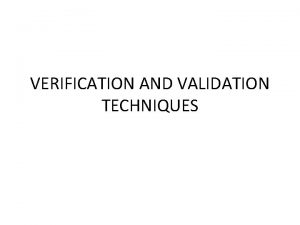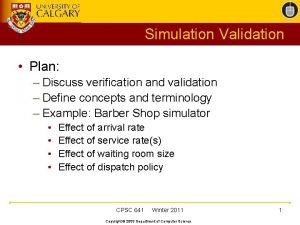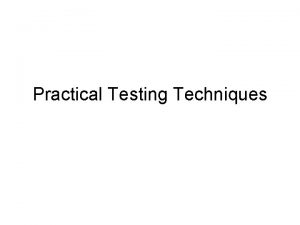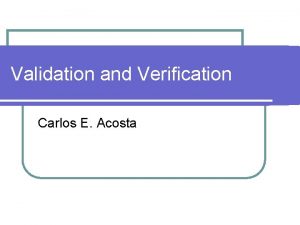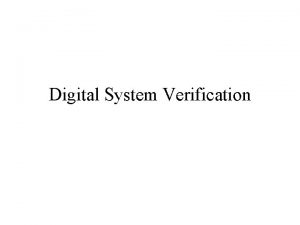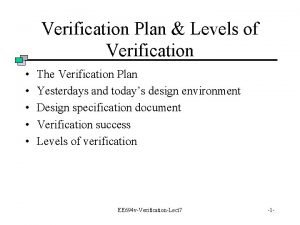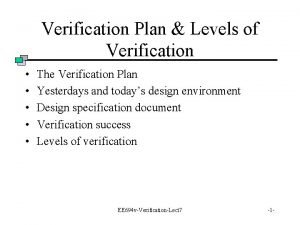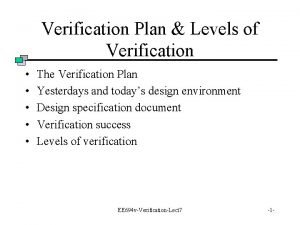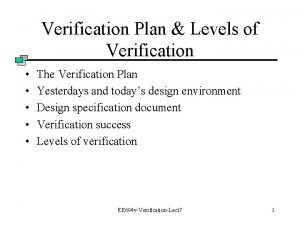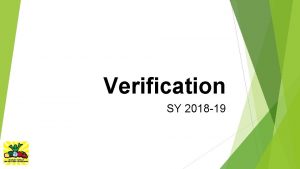Chapter 19 Verification and Validation Assuring that a














































- Slides: 46

Chapter 19 Verification and Validation Assuring that a software system meets a user’s need ©IS&JCH 050411 Software Engineering Chapter 19 Slide 0 of 45

Objectives are to l introduce software verification and validation (V&V) and to discuss the distinction between them, l describe the program inspection process and its role in V&V, l explain static analysis as a verification technique, l describe the Clean-Room software development process. ©IS&JCH 050411 Software Engineering Chapter 19 Slide 1 of 45

Topics covered l l Verification and validation planning Software inspections Automated static analysis Clean-room software development ©IS&JCH 050411 Software Engineering Chapter 19 Slide 2 of 45

Verification vs. validation l Verification: Are we building the product right? The software should conform to its specification. l Validation: Are we building the right product? The software should do what the user really requires. ©IS&JCH 050411 Software Engineering Chapter 19 Slide 3 of 45

The V&V process l l is a whole life-cycle process, i. e. , it must be applied at each and every stage in the software process. has two principal objectives, viz. , • discovery of defects in a system, and • assessment of usability in an operational situation. ©IS&JCH 050411 Software Engineering Chapter 19 Slide 4 of 45

Static and dynamic verification l Software inspections: concerned with analysis of the static system representation to discover problems (static verification). May be supplemented by tool-based document and code analyses. l Software testing: concerned with exercising and observing product behavior (dynamic verification). The system is executed with test data and its operational behaviour is observed. ©IS&JCH 050411 Software Engineering Chapter 19 Slide 5 of 45

Static and dynamic V&V ©IS&JCH 050411 Software Engineering Chapter 19 Slide 6 of 45

Program testing l l Can reveal the presence of errors but CANNOT prove their absence A successful test is a test which discovers one or more errors The only validation technique for non-functional requirements Should be used in conjunction with static verification to provide full V&V coverage ©IS&JCH 050411 Software Engineering Chapter 19 Slide 7 of 45

Types of testing l Defect testing • • • l It is designed to discover system defects. A successful defect test is one which reveals at least one defect. Covered in Chapter 20 Statistical (or operational) testing • • It is designed to reflect the frequency of user inputs. Used for reliability estimation. Covered in Chapter 21 ©IS&JCH 050411 Software Engineering Chapter 19 Slide 8 of 45

V&V goals Verification and validation should establish confidence that the software is acceptable for the intended use. This does NOT mean completely free of defect. Rather, it must be good enough for its intended use and the type of use will determine the degree of confidence that is needed. ©IS&JCH 050411 Software Engineering Chapter 19 Slide 9 of 45

V&V confidence Depends on the system’s purpose, user expectations, and marketing environment • • • Software function The level of confidence depends on how critical the software is to an organisation User expectations Users may have low expectations of certain kinds of software Marketing environment Getting a product to market early may be more important than finding defects in the program ©IS&JCH 050411 Software Engineering Chapter 19 Slide 10 of 45

Testing and debugging l l Defect testing and debugging are distinct processes Verification and validation is concerned with establishing the existence of defects in a program Debugging is concerned with locating and repairing these errors Debugging involves formulating a hypothesis about program behaviour, and then testing these hypotheses to find the system error ©IS&JCH 050411 Software Engineering Chapter 19 Slide 11 of 45

The debugging process ©IS&JCH 050411 Software Engineering Chapter 19 Slide 12 of 45

V & V planning l l Careful planning is required to get the most out of testing and inspection processes Planning should start early in the development process The plan should identify the balance between static verification and testing Test planning is about defining standards for the testing process rather than describing product tests ©IS&JCH 050411 Software Engineering Chapter 19 Slide 13 of 45

The V-model of development ©IS&JCH 050411 Software Engineering Chapter 19 Slide 14 of 45

The structure of a software test plan l l l l The testing process Requirements traceability Tested items Testing schedule Test recording procedures Hardware and software requirements Constraints ©IS&JCH 050411 Software Engineering Chapter 19 Slide 15 of 45

Software inspections l l Involve people examining the source representation with the aim of discovering anomalies and defects Do not require execution of a system so may be used before implementation May be applied to any representation of the system (requirements, design, test data, etc. ) Very effective technique for discovering errors if done properly ©IS&JCH 050411 Software Engineering Chapter 19 Slide 16 of 45

Inspection success l l Many different defects may be discovered in a single inspection. In testing, not all statements will be involved in every test execution. Thus several executions are required. When we find an error in an inspection, we also know its nature and location. That is not so in testing. ©IS&JCH 050411 Software Engineering Chapter 19 Slide 17 of 45

Inspections and testing l l Inspections and testing are complementary and not opposing verification techniques Both should be used during the V & V process Inspections can check conformance with a specification but not conformance with the customer’s real requirements Inspections cannot check non-functional characteristics such as performance, usability, etc. ©IS&JCH 050411 Software Engineering Chapter 19 Slide 18 of 45

Inspection pre-conditions l l l A precise specification must be available Team members must be familiar with the organization standards Syntactically correct code must be available An error checklist should be prepared Management must accept that inspection will increase costs early in the software process Management must not use inspections for staff appraisal ©IS&JCH 050411 Software Engineering Chapter 19 Slide 19 of 45

The inspection process ©IS&JCH 050411 Software Engineering Chapter 19 Slide 20 of 45

Inspection procedure l l l System overview is presented to the inspection team Code and associated documents are distributed to inspection team in advance Inspection takes place and discovered errors are noted Modifications are made to repair discovered errors Re-inspection may or may not be required, depending on the density and severity of defect discovered ©IS&JCH 050411 Software Engineering Chapter 19 Slide 21 of 45

Inspection team l l l An inspection team should consist of at least 4 members, each plays one or more of the following roles: Author (or owner) who fixes defects discovered Inspector who finds errors, omissions, and inconsistencies Secretary (Scribe) who records the results of the inspection meeting Reader who paraphrases the code Moderator who chairs the meeting and reports the results ©IS&JCH 050411 Software Engineering Chapter 19 Slide 22 of 45

Inspection checklists l l Checklist of common errors should be used to drive the inspection Error checklist is programming language dependent The 'weaker' the type checking, the larger the checklist Examples: Initialisation, Constant naming, loop termination, array bounds, etc. ©IS&JCH 050411 Software Engineering Chapter 19 Slide 23 of 45

Inspection check for data faults l l l Are all program variables initialized before use? Have all constants been named? Should the upper bound of arrays be equal to the size of the array or one less? If character strings are used, is a delimiter explicitly assigned? Is there any possibility of buffer overflow? ©IS&JCH 050411 Software Engineering Chapter 19 Slide 24 of 45

Inspection check for control faults l l l Is the condition correct for each conditional statement? Is each loop certain to terminate? Are compound statements correctly bracketed? Are all possible cases accounted for in each case statement? If a break is required after each case in case statements, has it been included? ©IS&JCH 050411 Software Engineering Chapter 19 Slide 25 of 45

Inspection check for I/O faults l l l Are all input variables used? Are all output variables assigned a value before they are output? Can unexpected input cause corruption? ©IS&JCH 050411 Software Engineering Chapter 19 Slide 26 of 45

Inspection check for interface faults l l Do all function and method calls have the correct number of parameters? Do formal and actual parameter types match? Are the parameters in the right order? If components access shared memory, do they have the same model of the shared memory structure? ©IS&JCH 050411 Software Engineering Chapter 19 Slide 27 of 45

Inspection check for storage management faults l l l Have all links been correctly reassigned (if a link structure is modified)? Has space been allocated correctly (if dynamic storage is used) Is space explicitly deallocated after it is no longer required? ©IS&JCH 050411 Software Engineering Chapter 19 Slide 28 of 45

Inspection check for exception handling faults Have all possible error conditions been taken into accounts? ©IS&JCH 050411 Software Engineering Chapter 19 Slide 29 of 45

Inspection rate l l l 500 statements/hour during overview 125 source statement/hour during individual preparation 90 -125 statements/hour can be inspected Inspection is therefore an expensive process Inspecting 500 lines costs about 40 man/hours effort $2, 000. ©IS&JCH 050411 Software Engineering Chapter 19 Slide 30 of 45

Automated static analysis l l l Static analysers are software tools for source text analysis. They scan the program text and try to discover potentially erroneous conditions and bring these to the attention of the V & V team. Very effective as an aid to inspections. A supplement to but not a replacement for inspections. ©IS&JCH 050411 Software Engineering Chapter 19 Slide 31 of 45

Checks that can be made through automatic static analysis fault types check list Data faults Variables used before initialization, declared but never used, assigned and assigned again before any use. Possible array bound violations. Undeclared variables. Control faults Unreachable code, unconditional branch into loops I/O faults Variables output twice without intervening assignment Interface faults Parameter type or number mismatches, unused results of functions, uncalled functions/procedures Storage faults Unassigned pointers, pointer arithmetic ©IS&JCH 050411 Software Engineering Chapter 19 Slide 32 of 45

Stages of static analysis l l l Control flow analysis. Checks for loops with multiple exit or entry points, finds unreachable code, etc. Data use analysis. Detects uninitialized variables, variables written twice without an intervening assignment, variables which are declared but never used, etc. Interface analysis. Checks the consistency of routine and procedure declarations and their use ©IS&JCH 050411 Software Engineering Chapter 19 Slide 33 of 45

Stages of static analysis l l l Information flow analysis. Identifies the dependencies of output variables. Does not detect anomalies itself but highlights information for code inspection or review Path analysis. Identifies paths through the program and sets out the statements executed in that path. Again, potentially useful in the review process Both these stages generate vast amounts of information. Must be used with care. ©IS&JCH 050411 Software Engineering Chapter 19 Slide 34 of 45

138% more lint_ex. c #include <stdio. h> printarray (Anarray) int Anarray; { printf(“%d”, Anarray); } main () { int Anarray[5]; int i; char c; printarray (Anarray, i, c); printarray (Anarray) ; } 139% cc lint_ex. c 140% lint_ex. c(10): warning: c may be used before set lint_ex. c(10): warning: i may be used before set printarray: variable # of args. lint_ex. c(4) : : lint_ex. c(10) printarray, arg. 1 used inconsistently lint_ex. c(4) : : lint_ex. c(11) printf returns value which is always ignored LINT static analysis

Use of static analysis l l Particularly valuable when a language such as C is used, which has weak typing and hence many errors are undetected by the compiler. Less cost-effective for languages like Java that have strong type checking, and can therefore detect many errors during compilation. ©IS&JCH 050411 Software Engineering Chapter 19 Slide 36 of 45

Clean-room software development l l The name is derived from the 'clean-room' process in semiconductor fabrication. The philosophy is defect avoidance rather than defect removal. Software development process based on: • • Incremental development. Static verification (i. e. , without test-execution). Formal specification. Statistical testing. ©IS&JCH 050411 Software Engineering Chapter 19 Slide 37 of 45

Incremental development l Instead of doing software design, implementation, and testing in sequence, the software is produced by building a number of executable increments. ©IS&JCH 050411 Software Engineering Chapter 19 Slide 38 of 45

Formal methods for spec. and design l l It uses "structured specifications" to divide the product functionality into deeply nested set that can be developed incrementally. It uses both structured specifications as well as state machine models. ©IS&JCH 050411 Software Engineering Chapter 19 Slide 39 of 45

Development without program execution l l l Functionally based programming developed by H. Mills is used to build the software right the first time. Developers are not allowed to test and debug the program. Developers use the techniques of code reading by stepwise abstraction, code inspection, group walkthrough, and formal verification to assert the correctness of their implementation. ©IS&JCH 050411 Software Engineering Chapter 19 Slide 40 of 45

Statistical testing l l Testing is done by a separate team. The test team develop an operational profile of the program, and perform a random testing. The independent testers assess and record the reliability of the product. The independent testers also use a limited number of test cases to ensure correct system operation for situations in which a software failure would be catastrophic. ©IS&JCH 050411 Software Engineering Chapter 19 Slide 41 of 45

Incremental development ©IS&JCH 050411 Software Engineering Chapter 19 Slide 42 of 45

Clean-room process teams l l l Specification team. Responsible for developing and maintaining the system specification. Development team. Responsible for developing and verifying the software. The software is NOT executed or even compiled during this process. Certification team. Responsible for developing a set of statistical tests to exercise the software after development. Reliability growth models used to determine when reliability is acceptable. ©IS&JCH 050411 Software Engineering Chapter 19 Slide 43 of 45

Clean-room process evaluation l l Results in IBM have been impressive with few discovered faults in delivered systems. Independent assessment shows that the process is no more expensive than other approaches. Fewer errors than in a 'traditional' development process. Not clear how this approach can be transferred to an environment with less skilled or less highly motivated engineers. ©IS&JCH 050411 Software Engineering Chapter 19 Slide 44 of 45

Key points l l Verification shows conformance with the specification whereas validation shows that the program meets the customer’s needs. Test plans should be drawn up to guide the testing process. Program inspections are effective in discovering errors. Static verification involves examination and analysis of the source code for error detection, and can be used to discover anomalies in the source code. ©IS&JCH 050411 Software Engineering Chapter 19 Slide 45 of 45
 Verification and validation
Verification and validation Verification and validation
Verification and validation Testing types in software engineering
Testing types in software engineering Verification and validation plan
Verification and validation plan Asme v&v 10
Asme v&v 10 Verification and validation
Verification and validation Verification and validation
Verification and validation Verification and validation plan
Verification and validation plan Verification and validation
Verification and validation A software verification and validation method. section 19
A software verification and validation method. section 19 Software verification and validation plan
Software verification and validation plan Is unit testing verification or validation
Is unit testing verification or validation Method verification vs validation
Method verification vs validation Method verification vs validation
Method verification vs validation Phân độ lown ngoại tâm thu
Phân độ lown ngoại tâm thu Block nhĩ thất độ 3
Block nhĩ thất độ 3 Thể thơ truyền thống
Thể thơ truyền thống Thơ thất ngôn tứ tuyệt đường luật
Thơ thất ngôn tứ tuyệt đường luật Chiến lược kinh doanh quốc tế của walmart
Chiến lược kinh doanh quốc tế của walmart Tìm độ lớn thật của tam giác abc
Tìm độ lớn thật của tam giác abc Hãy nói thật ít để làm được nhiều
Hãy nói thật ít để làm được nhiều Tôn thất thuyết là ai
Tôn thất thuyết là ai Gây tê cơ vuông thắt lưng
Gây tê cơ vuông thắt lưng Sau thất bại ở hồ điển triệt
Sau thất bại ở hồ điển triệt Validation and moderation
Validation and moderation Ist 331
Ist 331 Calibration master plan pdf
Calibration master plan pdf Pega express testing and validation
Pega express testing and validation A nested model for visualization design and validation
A nested model for visualization design and validation Mind incubation process
Mind incubation process Verification principle strengths and weaknesses
Verification principle strengths and weaknesses Shelf rectification and stock verification
Shelf rectification and stock verification Limit of linearity in analytical chemistry
Limit of linearity in analytical chemistry Sql injection waf bypass payloads
Sql injection waf bypass payloads Wpf validation.errortemplate
Wpf validation.errortemplate Concurrent validation
Concurrent validation Twic nexgen card
Twic nexgen card Struts2 workflow
Struts2 workflow Validation report
Validation report Arelle
Arelle Material obligation validation
Material obligation validation Why we use validation set
Why we use validation set Jsf number converter
Jsf number converter White box testing
White box testing Gefühle validieren beispiele
Gefühle validieren beispiele Software validation example
Software validation example Validation nach richard
Validation nach richard
